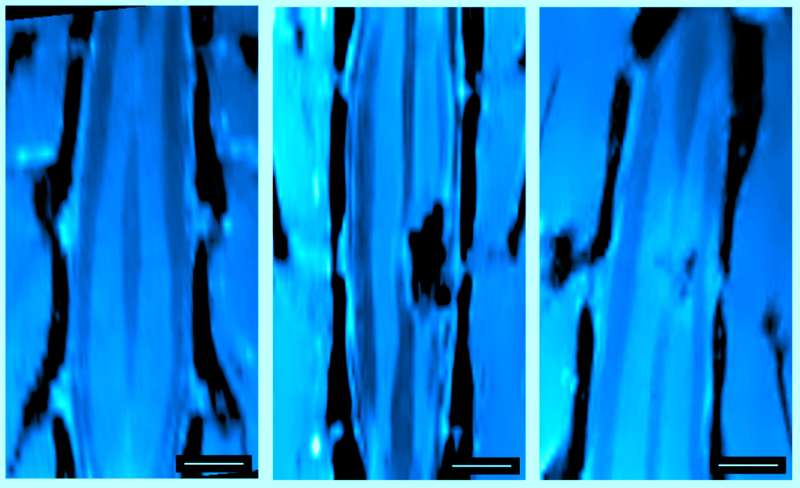From left to right: image of a healthy backbone (control); image of an injured backbone without an implant; image of an injured backbone in which the biocompatible nanomaterial has been implanted and where the neuronal reconnection can be observed. Credit: Author: Pedro Ramos / CIC biomaGUNE
Research conducted by two groups at the Center for Cooperative Research in Biomaterials CIC biomaGUNE and one at SISSA, Scuola Internazionale Superiore di Studi Avanzati (Italy), have shown that functional materials based on carbon nanotubes facilitate the reconnecting of neuronal networks damaged as a result of spinal cord injuries. The study, published by the scientific journal PNAS (Proceedings of the National Academy of Sciences), constitutes a huge step forward in research geared toward recovery from injuries of this type.
The research groups led by Ikerbasque Professor and Axa Chair at CIC biomaGUNE Maurizio Prato, who is a worldwide reference in carbon-based nanomaterials, and the one led by Professor Laura Ballerini at SISSA in Trieste (Italy) have experience in using nanotechnology and nanomaterials to repair neural injuries. Collaboration between the groups has shown that biomaterials based on carbon nanotubes facilitate communication between neurons, neuronal growth and the establishing of connections by means of materials of this type.
"The electrical and mechanical properties of this material enable many applications unthinkable for any other materials. In particular, the interaction of excitable cells, such as nerve and heart cells, make carbon nanotubes of great relevance. The communication among cells increases when interfaced with carbon nanotubes, and it is also possible to construct mechanically stable scaffolds that sustain nerve growth," says Professor Prato.
"The groups of Prato and Ballerini had previously demonstrated the formation of neuronal connections in in vitro systems in cell cultures. However, what still remained was the leap to an in vivo animal model of spinal cord lesion, the possibility of seeing whether the communications between individual neurons in fact also took place on the level of complete neuronal fibers in an in vivo model, and whether functional results were being achieved," explained Pedro Ramos, Ikerbasque professor at CIC biomaGUNE, leader of the Magnetic Resonance Imaging Unit and the third key player in the research.
In this latest breakthrough the researchers managed "to demonstrate that in a set of animals with partial cutting of the spinal cord, the reconnecting of fibers is in fact gradually established by means of the inserted implant, a kind of sponge of carbon nanotubes comprising interwoven fibers. The nerves reconnect in the area where they had been damaged and, what is more, the animals regained functionality, above all in the hind legs, the most affected by the lesion. It was also demonstrated that the material is biocompatible, in other words, no immune reaction was detected," said Pedro Ramos.
In his view, this significant breakthrough constitutes "a hope going forward in terms of furthering recovery from spinal cord injuries of this type, of the optic nerve, or even from some kind of traumatic injury in which neuronal connection has been lost and the mobility of a limb is affected." He adds that it will be some time before their research finds clinical application.
A goal on the horizon
As Ramos explained, the research was conducted "under highly controlled conditions, just like any lab study," and it is necessary to progress: "There are many aspects where work needs to be pursued in terms of the material, the conditions under which the material is implanted, the conditions under which the material has to work, etc."
For example, it is crucial to thoroughly explore the micro-structural and mechanical properties of the material, or the properties that facilitate neuronal connection, thus preventing possible side effects or even the rejection of the material itself (rigidity, elasticity, sponginess, compactness, size of the pores that remain between the fibers, etc.). It is also essential to further the production methods so that they are as stable and reproducible as possible, and so that components, such as growth factors or other substances that facilitate neuronal communication, can be inserted into its structure.
Furthermore, it is necessary to study the conditions that would allow clinical implanting of the materials: "It is important to see how and when they should be implanted. In the study, we inserted the implant during an acute lesion phase, so we did not have to contend with the existence of a glial scar, etc." In addition, "one would have to see whether these results are confirmed in other animal models with less neuronal plasticity."
One of the main aspects of this reconnection process is "to find out whether the same connections existing before the lesion are restored or whether neuronal plasticity takes place, in other words, whether new connections that did not exist previously are established and the nervous system seeks another way of reconnecting to adapt to the new situation." In this respect, in terms of imaging, "we are making progress in the development of functional imaging techniques that enable us to see the connections between the brain and the peripheral nervous system from a functional point of view," he said.
The CIC biomaGUNE researcher points out that "we are far from being able to transfer this to humans. It displays all the features of being transferrable, it has been demonstrated to work, to be effective and not to lead to any adverse reactions in animal models. Work remains to be done to achieve the goal, but we are heading in the right direction."
More information: Sadaf Usmani el al., Functional rewiring across spinal injuries via biomimetic nanofiber scaffolds.Proceedings of the National Academy of Sciences (2020). DOI: 10.1073/pnas.2005708117
Journal information: Proceedings of the National Academy of Sciences
Provided by Elhuyar Fundazioa
























